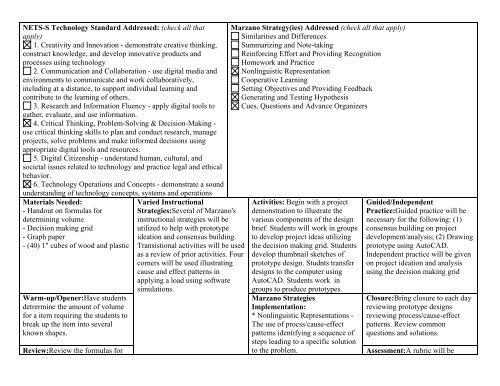Sample Lesson Plan - CTE
Sample Lesson Plan - CTE
Sample Lesson Plan - CTE
Create successful ePaper yourself
Turn your PDF publications into a flip-book with our unique Google optimized e-Paper software.
NETS-S Technology Standard Addressed: (check all that<br />
apply)<br />
1. Creativity and Innovation - demonstrate creative thinking,<br />
construct knowledge, and develop innovative products and<br />
processes using technology<br />
2. Communication and Collaboration - use digital media and<br />
environments to communicate and work collaboratively,<br />
including at a distance, to support individual learning and<br />
contribute to the learning of others.<br />
3. Research and Information Fluency - apply digital tools to<br />
gather, evaluate, and use information.<br />
4. Critical Thinking, Problem-Solving & Decision-Making -<br />
use critical thinking skills to plan and conduct research, manage<br />
projects, solve problems and make informed decisions using<br />
appropriate digital tools and resources.<br />
5. Digital Citizenship - understand human, cultural, and<br />
societal issues related to technology and practice legal and ethical<br />
behavior.<br />
6. Technology Operations and Concepts - demonstrate a sound<br />
understanding of technology concepts, systems and operations<br />
Materials Needed:<br />
- Handout on formulas for<br />
determining volume<br />
- Decision making grid<br />
- Graph paper<br />
- (40) 1" cubes of wood and plastic<br />
Warm-up/Opener:Have students<br />
detrermine the amount of volume<br />
for a item requiring the students to<br />
break up the item into several<br />
known shapes.<br />
Review:Review the formulas for<br />
Varied Instructional<br />
Strategies:Several of Marzano's<br />
instructional strategies will be<br />
utilized to help with prototype<br />
ideation and consensus building.<br />
Transistional activities will be used<br />
as a review of prior activities. Four<br />
corners will be used illustrating<br />
cause and effect patterns in<br />
applying a load using software<br />
simulations.<br />
Marzano Strategy(ies) Addressed (check all that apply)<br />
Similarities and Differences<br />
Summarizing and Note-taking<br />
Reinforcing Effort and Providing Recognition<br />
Homework and Practice<br />
Nonlinguistic Representation<br />
Cooperative Learning<br />
Setting Objectives and Providing Feedback<br />
Generating and Testing Hypothesis<br />
Cues, Questions and Advance Organizers<br />
Activities: Begin with a project<br />
demonstration to illustrate the<br />
various components of the design<br />
brief. Students will work in groups<br />
to develop project ideas utilizing<br />
the decision making grid. Students<br />
develop thumbnail sketches of<br />
prototype design. Studnts transfer<br />
designs to the computer using<br />
AutoCAD. Students work in<br />
groups to produce prototypes.<br />
Marzano Strategies<br />
Implementation:<br />
* Nonlinguistic Representations -<br />
The use of procss/cause-effect<br />
patterns identifying a sequence of<br />
steps leading to a specific solution<br />
Guided/Independent<br />
Practice:Guided practice will be<br />
necessary for the following: (1)<br />
consensus building on project<br />
development/analysis; (2) Drawing<br />
prototype using AutoCAD.<br />
Independent practice will be given<br />
on project ideation and analysis<br />
using the decision making grid<br />
Closure:Bring closure to each day<br />
reviewing prototype designs<br />
reviewing process/cause-effect<br />
patterns. Review common<br />
questions and solutions.<br />
to the problem. Assessment:A rubric will be


